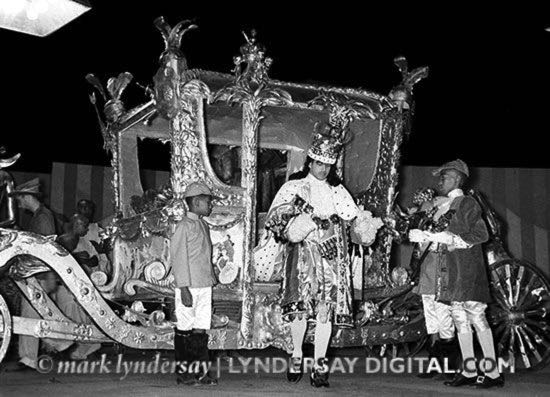Mining and refining photographic history
19/01/10 00:34 Filed in: Technique

Unidentified image of a King of the Bands masquerader.
Caribbean Beat published six images in the January/February 2010 edition from a new collection of images I’ve been working on. The story of how it came to be is in the accompanying text, but here’s some technical background on the project.
After my father died two years ago, my stepmother, Dani, brought an envelope of his hold negatives for me. I did not have anything resembling a close relationship with my father.
He separated from my mother when I was seven and except for some brief and profoundly unfulfilling visits that lasted until I hit my teens, I saw nothing of him for years at a time.
By the time I hit the age of 14, I had become that judgemental, all-knowing, absolutely assured in his anger person that we are certain will rule the world for the rest of our lives.

The last time I saw him, it was in a hospital and I was accompanying my mother on a visit to him that I suppose I really didn’t understand.
It is a surprising and probably appropriate consequence of the conveyance of this bag of history to me that in sifting through this bag of negatives that I would find an answer of sorts to that question among dozens of photos of the young couple.
Preparing the images for consideration by Caribbean Beat meant identifying them and editor Judy Raymond's sharing of the gallery of photos with calypso archivist Ray Funk and steelband historian Kim Johnson led to the work being viewed and analysed by a surprising number of knowledgeable students and practitioners of that era and the successful identification of many of the first batch of images that were scanned.
The negatives were in daunting condition. Mercifully free from the kind of dust that can infest old material of this kind, they were kept loose for decades and my father’s constant moves throughout his life had probably contributed to them rubbing against each other and developing grit scrapings.

Most of the fancy scanning technologies that are designed to improve the quality of images during the scanning process don’t work on black and white negatives. In fact, they fail catastrophically. That means that the capture process has to be as rich as possible because restoration will have to be done on the final scan for every image. Each of the images for this publication commanded roughly two hours of inch by inch restoration work.
What follows is now my process for the migration all of my film based assets.
I scan at the highest resolution and highest bitdepth possible. On the Nikon medium format scanner that I’m using, that’s 8,000 pixels on the longest side and 14 bits per channel. A full colour image captured at this resolution and bitdepth will clock in at roughly 450MB saved in TIFF format.

After almost a decade of scanning and rescanning images, I’m hoping that I don’t have to go back there and will be keeping these and other images in full resolution after they have been colour corrected and retouched. Clearly this is way more data that most licensing uses will call for, but it’s the closest that a digital image will come to representing the potential of the now ancient medium of negative and transparency.
Related: A slice of Carnival's history
As of this posting, the January-February edition of Caribbean Beat is not available on the magazine's website. Still, you can view their archives after a free signup process.
blog comments powered by Disqus